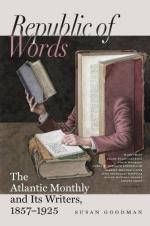From the east side we proceeded to the north, where the dead monks sleep in their cemetery, high over the watery gorge. In one corner of this inclosure, under a group of giant maples, is the grave of King Magnus of Sweden, who is said to have perished by shipwreck on the island. Here, in the deep shade, a solemn mass for the dead was chanted. Nothing could have added to the impressiveness of the scene. The tapers burning under the thick-leaved boughs, the light smoke curling up in the shade, the grave voices of the monks, the bending heads of the beautiful-haired crowd, and the dashes of white, pink, scarlet, blue, and gold in their dresses, made a picture the solemnity of which was only heightened by its pomp of color. I can do no more than give the features; the reader must recombine them in his own mind.
The painter accompanied us to the place called Jelesniki, which, after a walk of four miles through the forests, we found to be a deserted village, with a chapel on a rocky headland. There was a fine bridge across the dividing strait, and the place may have been as picturesque as it was represented. On that side of the islands, however, there was a dense fog, and we could get no view beyond a hundred yards. We had hoped to see reindeer in the woods, and an eagle’s nest, and various other curiosities; but where there was no fog there were mosquitoes, and the search became discouraging.
On returning to the monastery, a register was brought to us, in which, on looking back for several years, we could find but one foreign visitor,—a Frenchman. We judged, therefore, that the abbot would possibly expect us to call upon him, and, indeed, the hospitality we had received exacted it. We found him receiving visitors in a plain, but comfortable room, in a distant part of the building. He was a man of fifty-five, frank and self-possessed in his manners, and of an evident force and individuality of character. His reception of the visitors, among whom was a lady, was at once courteous and kindly. A younger monk brought us glasses of tea. Incidentally learning that I had visited the Holy Places in Syria, the abbot sent for some pictures of the monastery and its chosen saints, which he asked me to keep as a souvenir of Valaam. He also presented each of us with a cake of unleavened bread, stamped with the cross, and with a triangular piece cut out of the top, to indicate the Trinity. On parting, he gave his hand, which the orthodox visitors devoutly kissed. Before the steamer sailed, we received fresh evidence of his kindness, in the present of three large loaves of consecrated bread, and a bunch of lilacs from the garden of the monastery.




